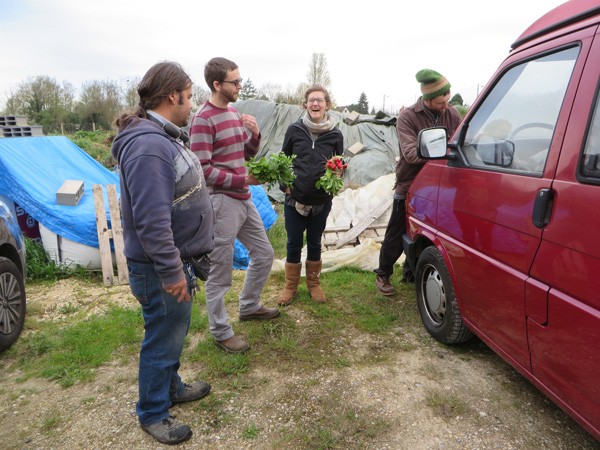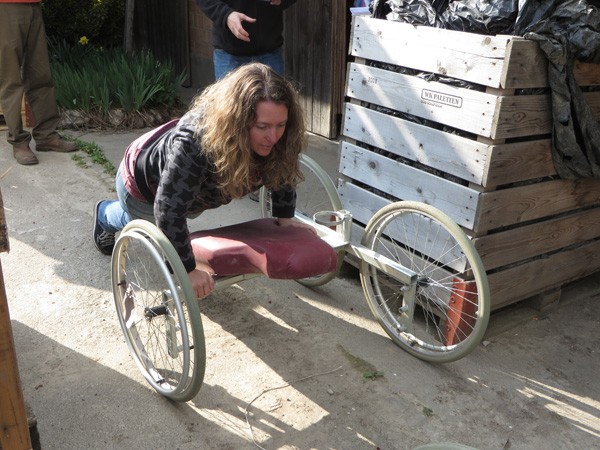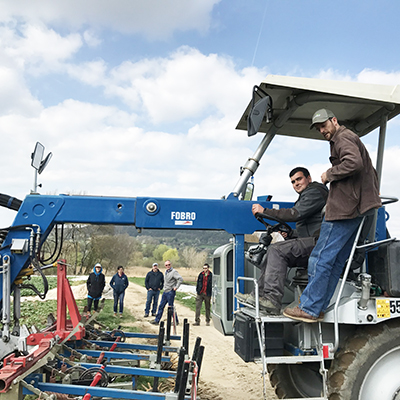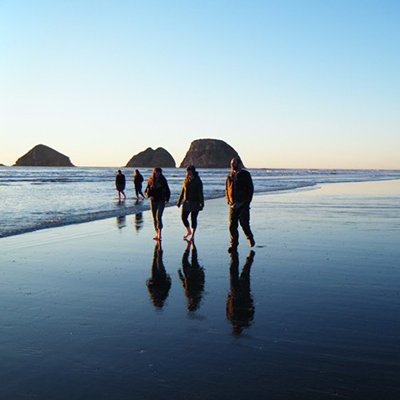At the end of March I traveled to Europe for 15 days to learn more about mechanical weeding tools. My plan was to visit weeding tool manufacturers in the Netherlands, attend an academic conference on physical weed control in Switzerland, and then tour vegetable farms in Switzerland. I was blessed with a veritable dream team of travel companions: My sister Claire met me in the Netherlands and filmed and coordinated our meetings with tool manufacturers. In Switzerland I fell in with my professor, well-experienced with organic weed control, and another graduate student studying organic squash cultivation.
Thanks to a grant from the USDA’s Sustainable Agriculture, Research, and Education Program, four vegetable growers from Wisconsin and Michigan joined us in Switzerland. There was Denae Friedheim, director of the Student Organic Farm at Michigan State University. In the past she ran a greenhouse growing starts for vegetable growers. Then came Les Roggenbuck, a lifelong farmer from Eastern Michigan. He grew up growing beets and grain and transitioned to organic in the mid-‘90s. Les markets vegetables and meat to his CSA and farmers market. And finally, from the great state of Wisconsin, Paul and Sara Huber, who grow on 2 acres outside of Milwaukee, selling vegetables and eggs to their free-choice CSA and farmers market. With so many experienced perspectives I was able to see through many eyes and learned a lot more than I could have alone.
I saw countless implements for weeding, seeding, transplanting and soil-working. My mind was expanded as to the possibilities for quality and speed of work. And while I will write about novel technical aspects in an article in the August GFM, what stands out most brightly are the people that I met and the agricultural systems they are a part of, and that is what I would like to share with you here.
Just as the soil contains its own myriad characters and relationships, water vapor, bacteria, and worms, that all play interconnected roles to create fertility, so too I found the world of European vegetable growing to be peopled by many levels and relationships. The entity with the biggest effect on all the others, the tillage if you will, was always the governments. In each country the government played a large role in determining how farming is practiced. Whereas here we prize individual freedom and often put it before proper stewardship of our shared resources, in the European countries I visited the opposite seemed to be true- communal resources like water, soil, and the social fabric of rural communities are protected, often to the detriment of individual freedom. A lot of farmers I met realized this contrast between our countries and talking about it was a nice cultural exchange.
Soon after our arrival, and still jet-lagged, Paul, Sara, my sis and I made our way to ‘Ferme Erwan’, or Erwan’s Farm which lay in a suburb of Paris. Over the afternoon this French vegetable farmer five years established showed us his farm and told us his story and we learned about the intense involvement of the French government in agriculture. Some rules were maddening while others assisted him greatly.

Erwan was not allowed to begin farming until he had completed a one-year program at the ag school. I asked him how the government could stop him from farming. “You see,” he said, “renting farmland is regulated by the government, so they decide who can rent.” All of the countries I visited have a higher population density than ours and correspondingly, farmland is much more expensive. Because of this most farmers rent.
Erwan thought the agricultural schooling a waste of his time, but while he was attending he was also gaining experience through an official apprenticeship with a local grower and meeting people in the community. It was during this year that he met the retiring farmer from whom he now rents his land, and more importantly perhaps, he connected with a national people’s organization called the “Association for the Maintenance of Peasant Agriculture” or AMAP. The local branch in his Parisian suburb wanted a CSA farm and they recruited Erwan to be their farmer - talk about community support.

When Erwan graduated from the Agriculture school he had a group of subscribers ready and he was now officially a farmer in the eyes of the government, which entitled him to a lot of help. Like the US, many European governments give farmers money for practices they want to encourage. In Erwan’s case he received money for being a beginning farmer, for being a vegetable farmer, and for being organic. Implements, a tractor, a new barn and large cooler were all acquired with the government footing about half the cost. But there are intense regulations surrounding all of these things – for example his hoophouse needed to be certified to hold a specific number of kilograms per square meter of trellised tomatoes.
All of us were surprised by the depth of support that Erwan enjoys from his CSA members. Rather than the trend I see in our country of desperate CSA farmers catering towards the convenience of their members, Erwan’s members seemed to go out of their way to help him and were very involved in his farm. In addition to frequent harvest parties members attend cooking classes in the barn’s commercial kitchen and teach workshops about farming and nature. While we were inspecting the barn a group of children came through to learn from a CSA member about the role of birds on a farm.
Erwan’s post-harvest handling also blew my mind. Because his clay soil is a huge pain for him to remove, Erwan does not wash any vegetables – his members take them dirty and wash the produce themselves! It was the end of March, and he pulled some pretty rough looking storage carrots out of the cooler. “Can you sell those carrots?” I asked him. Erwan chuckled, befuddled that we were not understanding his business model and the connection he has with his CSA members. He replied “I don’t have to sell them, they are already sold [to my members].” To me, giving out sub-par carrots was stretching member support a bit far, but it also demonstrates the lengths his members are willing to go to support their farmer.
We all had to broaden our minds to understand how Erwan’s farm worked, and after leaving, a dinner of duck and French wine facilitated our reflecting. Later in the evening Claire, Paul, Sara and I were snug as bugs in the rented campervan and giggling like middle school girls at a slumber party until we fell asleep in the soft night. Early in the morning Erwan surprised us by bringing breakfast, and we all enjoyed croissants, coffee, and conversation in the barn’s meeting room, where the day before children had gathered for their class on birds. We had full itineraries planned in order to make the most of this European research trip, so Claire and I bid goodbye to Paul and Sara as they drove off for four days of visiting French vegetable farms. Meanwhile Claire and I caught a train to the Netherlands. And I was brimming with excitement at visiting the mecca of mechanized vegetable cultivation.
The Dutch seem to have an instinct for intensive and efficient agriculture, perhaps because arable land is dear, having been wrested acre by acre from the sea. Outside of a University town we met André Jurias, a large organic grower of potatoes, onions, cabbage, and carrots. André rents his entire farm and through a brisk wholesaling business has invested deeply in large equipment and technology that allows him and one other full-time employee to cultivate hundreds of acres. When he showed me the recently completed multi-story solar-powered cooler I asked him how he felt about investing in capital improvements on land he does not own. André explained by telling me that the Dutch government regulates long-term agricultural leases in order to encourage stability for those farmers who rent their entire farm, whereas if you are renting some fields for a few seasons it is your business.
I was told that in the Netherlands his long-term lease means that André can stay on his farm until he is 65, and that kicking him off before then would be a hard process. When he wants to make a capital investment, like the cooler, he and his landlord agree on it (which seemed not be an issue), then later when André leaves the farm at 65 the owner will pay him back for his improvements minus depreciation. André seemed very happy with the arrangement. I also learned how closely some farming practices are regulated. For example, to prevent erosion and nutrient leaching no sandy fields are allowed to lie bare over the winter, they must all have a cover crop otherwise the grower is fined. André didn’t seem to mind this as he thought it was just good farming that protected the water and soil of his country.
After three days in the Netherlands I was off to Switzerland, where I was amazed by the kindness of the growers and the number of vegetable farms I passed by on the highway. Seemingly every ten minutes I would pass hoophouses, row cover, or other hallmarks of vegetable production. Whereas I observe no such density of vegetable production in Michigan or Western Wisconsin, which are known for their vegetable farms. What gave? I asked a Swiss farmer what accounted for this density of vegetable growers and she explained that Switzerland, not being a member of the European Union, is free to decide its own import taxes. There are two tax levels for foreign produce – in the winter import taxes are low so vegetables come in from Southern climes, but once the growing season begins import taxes increase steeply, so that Swiss produce is in high demand during the entire season.
It has been a month since I returned from this European vegetable sojourn, and I am still understanding everything that I learned, trying to fit all the pieces into a few pictures that make sense of it all. One facet that is clear to me from the Swiss and the Dutch farmers is the high degree of development of the vegetable-growing economy. What I mean is that there are many types of businesses all related to vegetable growing that help support the actual growers. For example, all of the farms I visited used soil-block transplants, but none of them grew the transplants themselves. There were plenty of nurseries nearby to grow transplants and deliver them on the day the growers wanted, which is one less process and set of investments for the grower to take on. This custom-growing is especially helpful for grafted plants, where some skill and equipment is necessary.
Similarly, whereas in the US we can contract someone to custom-harvest our corn and beans, André, the Dutch grower, has his cabbage, potatoes, and carrots custom-harvested, which again means that he does not have to buy several expensive pieces of equipment. Also, because of the custom harvester’s scale, André’s vegetable crops are harvested in a smaller window of time than he would be able to harvest himself.
It seems that there is a critical mass of vegetable farmers that sustains a web of ancillary businesses that in turn support the growers- a really nice cycle. By specializing, these businesses offer a product or service that is of higher quality, faster, or cheaper than what the growers would manage on their own. I am always happy to see evidence of this vegetable-growing economy through the advertisements in these pages, where one can find many businesses whose products and services make a vegetable grower’s life easier.

I hope that I have conveyed some of the unique aspects of vegetable growing that I observed in Europe. Of course some things are the same everywhere, such as the warmth and generosity of farmers. Speaking of which, I would like to acknowledge Michigan’s vegetable growers and the federal government, because the USDA’s SARE program and the Michigan Vegetable Council supported this trip. Unfortunately it is too easy to see waste or overreach in government programs, but there are also many positive effects, such as encouraging good farming practices and the exchange of knowledge between countries. Though it is crucial, government money is created by the stroke of a pen, and so what really makes me proud is the support of Michigan vegetable farmers who, by being organized, give of their hard-earned dollars to support the bigger picture.
Sam Hitchcock Tilton is a former and aspiring vegetable grower who has visited with farmers around the world. He is currently studying for a Master’s degree at Michigan State University, focusing on organic weed control and researching, testing, and building mechanical weeding machines. He has a passion for developing the finest popcorn strain and enjoys learning more and sharing his knowledge.



